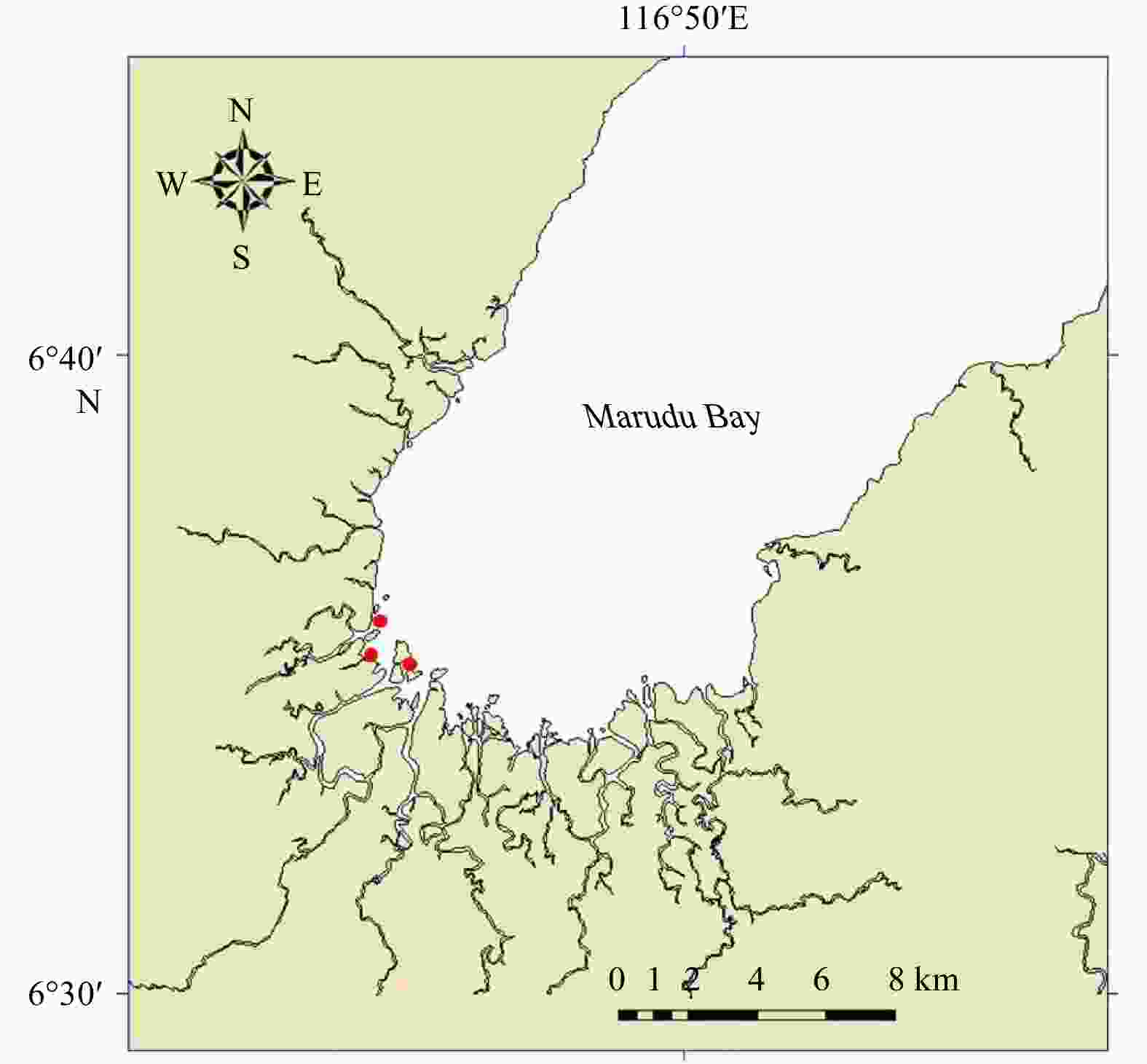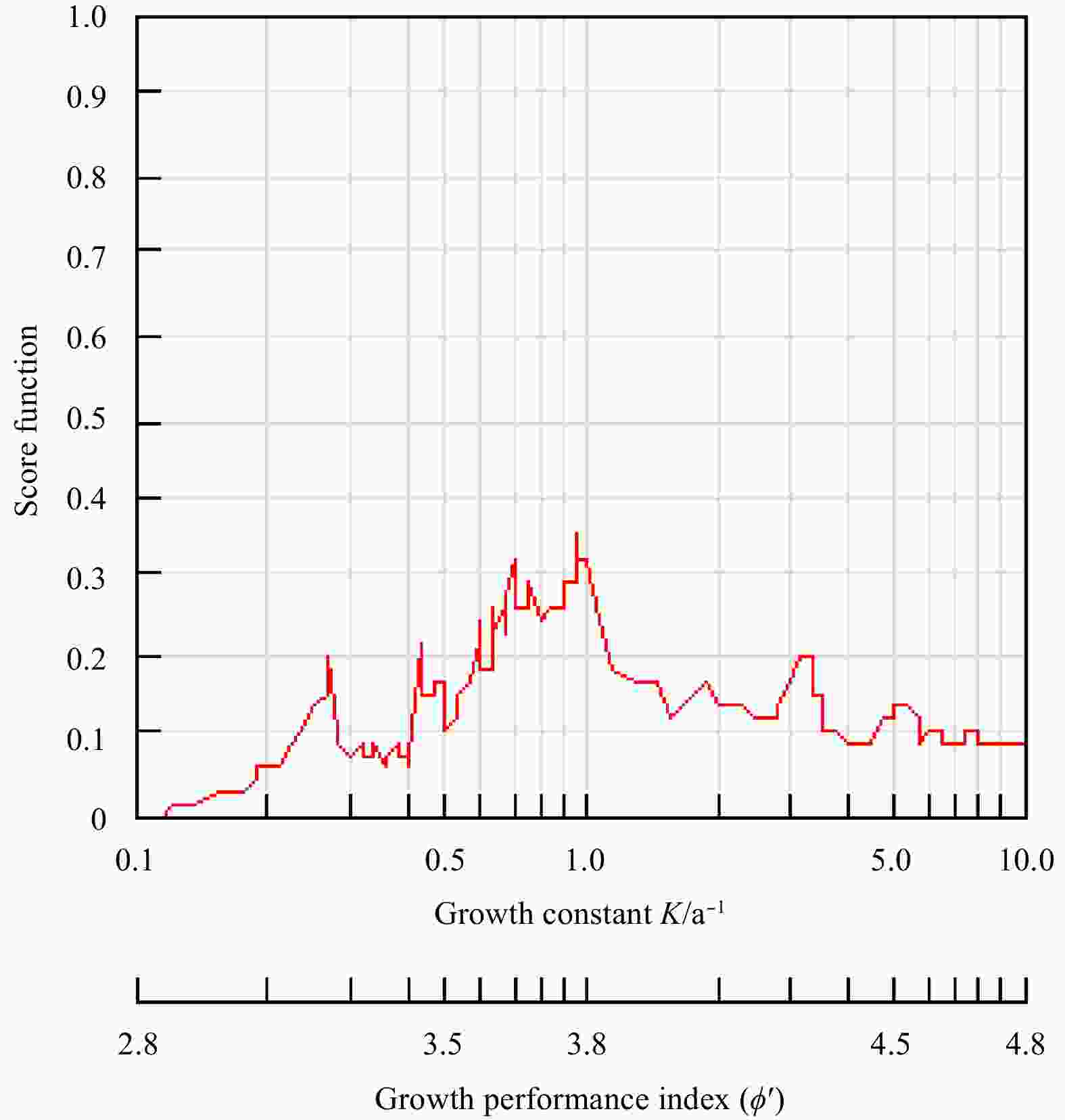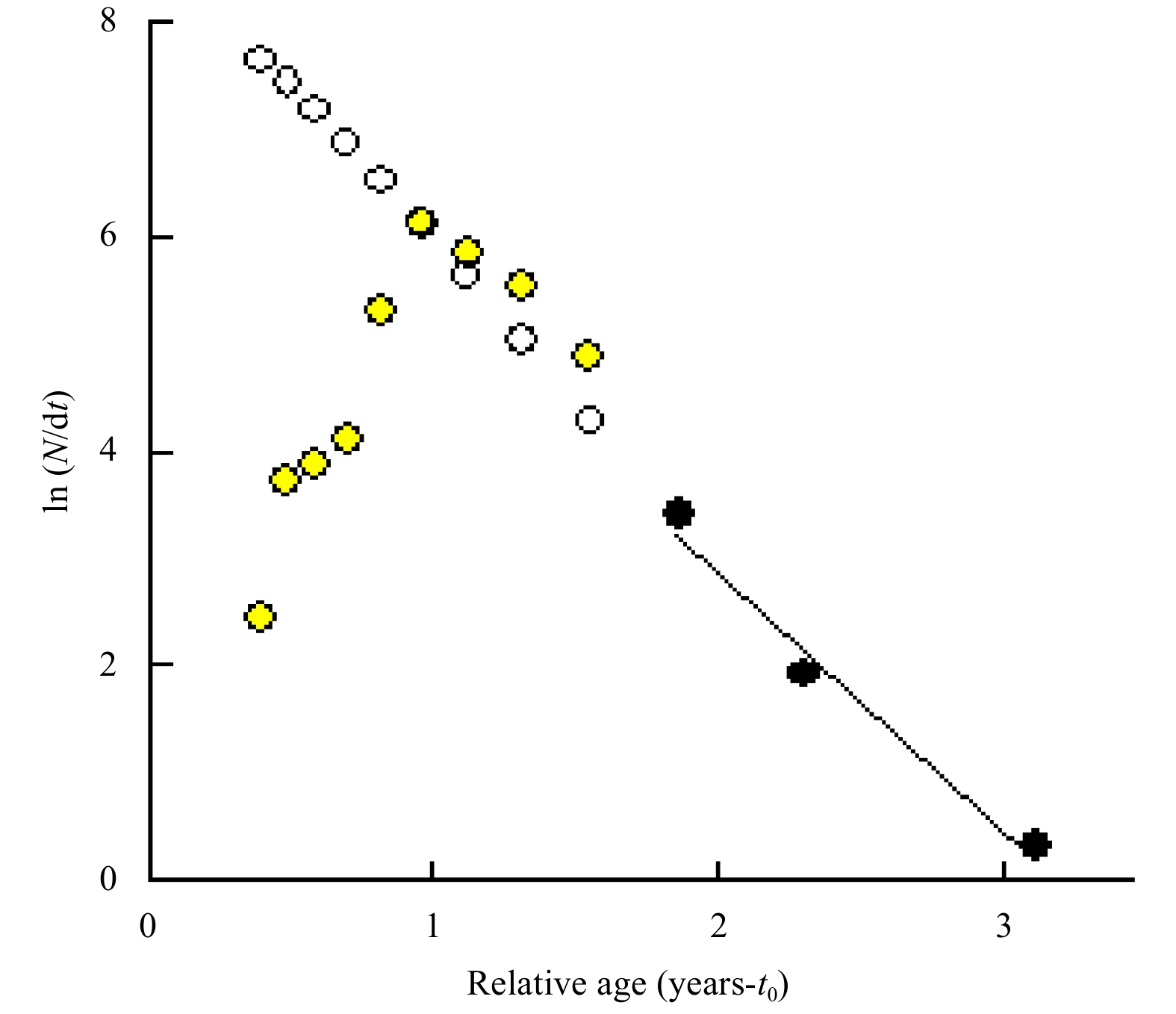Population dynamics and condition index of natural stock of blood cockle, Tegillarca granosa (Mollusca, Bivalvia, Arcidae) in the Marudu Bay, Malaysia
-
Abstract: The population parameters of blood cockles, Tegillarca granosa in the intertidal zone of Marudu Bay, Sabah, Malaysia were investigated based on monthly length-weight frequency data (July 2017 to June 2018). A total of 279 cockle individuals with shell length and weight ranging from 27.7 mm to 82.2 mm and 13.11 g to 192.7 g were subjected to analysis. T. granosa in Marudu Bay showed a consistent moderately high condition index 4.98±0.86 throughout the year. The exponent b of the length-weight relationship was 2.6 demonstrating negative allometric growth. The estimated asymptotic length (L∞), growth coefficient (K) and growth performance (ϕ) of the T. granosa population in Marudu Bay were estimated at 86.68 mm, 0.98 a–1 and 3.87, respectively. The observed maximum shell length was 82.55 mm and the predicted maximum shell length was 84.44 mm with estimated maximum life span (tmax) of 3.06 years. The estimated mean lengths at the end of 2, 4, 6, 8, 10 and 12 months of age were 21.31 mm, 31.16 mm, 39.53 mm, 46.63 mm, 52.67 mm and 57.79 mm. Total, natural, and fishing mortalities were estimated at 2.39 a–1, 1.32 a–1 and 1.07 a–1. The exploitation level (E) was 0.45. Results of the current study also demonstrated that T. granosa in the Marudu Bay has two major recruitment peaks; one in March and another in October. The exploitation level revealed that natural stock of T. granosa in the Marudu Bay was approaching the maximum exploitation level. If such trend continues or demand for T. granosa is increasing, coupled with no effective fisheries management in place, possibility of the T. granosa population in the Marudu Bay to collapse is likely to elevate.
-
Key words:
- Arcidae /
- population dynamics /
- condition index /
- Marudu Bay
-
Table 1. Length-weight frequency data of Tegillarca granosa in the Marudu Bay from July 2017 to June 2018
Midlength/mm Jul. 2017 Aug. 2017 Sept. 2017 Oct. 2017 Nov. 2017 Dec. 2017 Jan. 2018 Feb. 2018 Mar. 2018 Apr. 2018 May 2018 Jun. 2018 27.5 1 0 0 0 0 0 0 0 0 0 0 0 32.5 4 0 0 0 0 0 0 0 0 0 0 0 37.5 3 0 1 0 0 0 0 0 0 0 0 1 42.5 0 1 1 0 1 0 1 0 2 0 0 1 47.5 4 0 3 0 7 2 3 3 2 1 0 1 52.5 27 8 1 4 5 4 3 4 3 4 1 4 57.5 9 1 3 5 8 0 4 7 7 5 3 9 62.5 5 6 4 3 5 4 2 8 2 2 4 9 67.5 2 4 5 1 9 2 1 4 3 0 2 3 72.5 0 0 1 0 7 0 0 0 0 1 1 1 77.5 0 0 1 1 2 0 0 0 0 0 0 0 82.5 0 0 0 0 1 1 0 0 0 0 0 0 Total 55 20 20 14 45 13 14 26 19 13 11 29 Note: 0 represents no cockle found. Table 2. Comparison of condition index for Tegillarca granosa recorded in the Marudu Bay with published data
Location Species Condition index (±SD) Reference Marudu Bay, Malaysia Tegillarca granosa 4.98±0.86 current study Straits of Malacca, Malaysia Anadara granosa 6.76±1.13 Khalil et al. (2017) Black Sea Coast, Turkey A. granosa 7.88±1.80 Sahin et al. (2006) Kakinada Bay, India A. granosa 4.11 Narasimham (1988a) Table 3. Comparison of estimated length-weight relationship parameters for Tegillarca granosa in the Marudu Bay with published values
Location Species a b Reference Marudu Bay, Malaysia Tegillarca granosa 0.664 2.60 current study Balik Pulau, Malaysia Anadara granosa 0.002 2.33 Mirzaei et al. (2015) Sungai Buloh, Malaysia A. granosa 0.240 3.37 Broom (1982) Kakinada Bay, India A. granosa 0.260 2.12 Narasimham (1988b) Thailand A. granosa 0.360 3.04 Boonruang and Janekarn (1983) Note: a is the intercept (condition factor) and b is the slope (growth coefficient). Table 4. Comparison of growth and mortality parameters for Tegillarca granosa in the Marudu Bay with published data
Location Species L∞/mm K/a–1 F/a–1 E Reference Marudu Bay, Malaysia Tegillarca granosa 86.68 0.98 1.07 0.45 current study Balik Pulau, Malaysia Anadara granosa 35.4 1.1 0.48 0.16 Mirzaei et al.(2015) Kuala Juru, Malaysia A. granosa 45 0.55 2.69 0.83 Oon (1986) Kuala Sepetang, Malaysia A. granosa 40.5 0.79 3.33 0.81 Oon (1986) Sungai Besar Selangor, Malaysia A. granosa 41.4 0.78 2.88 0.79 Oon (1986) Pulau Sangga, Malaysia A. granosa 37.2 0.88 2.05 0.7 Oon (1986) Sungai Buloh, Malaysia A. granosa 44.4 1.01 – – Broom (1982) Kakinada Bay, India A. granosa 73.4 0.58 – – Narasimham (1988b) Ang Sila, Thailand A. granosa 36.9 1.86 – – Vakily (1992) Desa Menco, Indonesia A. granosa 129.9 0.07 – – Imtihan et al. (2014) Kecamatan Wedung, Indonesia A. granosa 112.1 0.07 – – Imtihan et al. (2014) Demak, Indonesia A. granosa 106.8 0.06 – – Imtihan et al. (2014) Note: L∞: estimated asymptotic length; K: growth coefficient; F: estimated fishing mortality; E: estimated exploitation level. Table 5. Spawning peaks of blood cockles recorded within the Southeast Asian region
Location Species Spawning period Reference Marudu bay, Malaysia Tegillarca granosa March to April and September to October current study Pulau Pinang, Malaysia Anadara granosa February to March and October Khalil et al. (2017) Pulau Pinang, Malaysia A. granosa August to September Broom (1983) Selangor, Malaysia A. granosa September and November Broom (1983) Phuket, Thailand A. granosa October to November Boonruang and Janekarn (1983) Pattani Bay, Thailand A. granosa September and December Suwanjarat et al. (2009) Banda Aceh, Indonesia A. granosa September to October Khalil et al. (2017) Lhokseumawe, Indonesia A. granosa September to October Khalil et al. (2017) -
[1] Beverton R J H, Holt S J. 1993. On the Dynamics of Exploited Fish Populations. Dordrecht, the Netherlands: Springer [2] Boonruang P, Janekarn V. 1983. Distribution, density, biomass and population bionomics of Anadara granosa (L.) in relation to environmental factors at Sapum Bay on the east coast of Phuket Island. Thai Fisheries Gazette, 36: 461–468 [3] Broom M J. 1982. Analysis of the growth of Anadara granosa (Bivalvia: Arcidae) in natural, artificially seeded and experimental populations. Marine Ecology Progress Series, 9: 69–79. doi: 10.3354/meps009069 [4] Broom M J. 1983. Mortality and production in natural, artificially-seeded and experimental populations of Anadara granosa (Bivalvia: Arcidae). Oecologia, 58(3): 389–397. doi: 10.1007/BF00385241 [5] Broom M J. 1985. The biology and culture of marine bivalve molluscs of the genus Anadara. ICLARM Studies and Reviews, 12: 1–37 [6] Carlander K D. 1997. Handbook of Freshwater Fishery Biology. Ames, IA, USA: Iowa State University Press [7] Dame R F. 1993. Bivalve Filter Feeders in Estuarine and Coastal Ecosystem Processes. Berlin Heidelberg, Germany: Springer, 455–476 [8] Davenport J, Chen Xiaogang. 1987. A comparison of methods for the assessment of condition in the mussel (Mytilus edulis L.). Journal of Molluscan Studies, 53: 293–297. doi: 10.1093/mollus/53.3.293 [9] Davenport J, Wong T M. 1986. Responses of the blood cockle Anadara granosa (L.) (Bivalvia: Arcidae) to salinity, hypoxia and aerial exposure. Aquaculture, 56: 151–162. doi: 10.1016/0044-8486(86)90024-4 [10] De Young C, Charles A, Hjort A. 2008. Human dimensions of the ecosystem approach to fisheries: an overview of context, concepts, tools and methods. Rome, Italy: Food and Agriculture Organization of the United Nations, 3–9 [11] Department of Fisheries Malaysia. 2013. Perangkaan Tahunan Perikanan 2013. https://www.dof.gov.my/index.php/pages/view/82 [2020−1−21] [12] Engle J B. 1958. The seasonal significance of total solids of oysters in commercial exploitation. Proceedings National Shellfisheries Association, 48: 72–78 [13] Faulkner P. 2010. Morphometric and taphonomic analysis of granular ark (Anadara granosa) dominated shell deposits of Blue Mud Bay, northern Australia. Journal of Archaeological Science, 37(8): 1942–1952. doi: 10.1016/j.jas.2010.02.021 [14] Fréchette M, Aitken A E, Pagé L. 1992. Interdependence of food and space limitation of a benthic suspension feeder: consequences for self-thinning relationships. Marine Ecology Progress Series, 83: 55–62. doi: 10.3354/meps083055 [15] Freites L, Montero L, Arrieche D, et al. 2010. Influence of environmental factors on the reproductive cycle of the eared ark Anadara notabilis (Röding, 1798) in northeastern Venezuela. Journal of Shellfish Research, 29(1): 69–75. doi: 10.2983/035.029.0128 [16] Galtsoff P S. 1965. The American oyster, Crassostrea virginica Gmelin. Washington, DC, USA: Fish and Wildlife Services, 480 [17] Gayanilo F, Sparre P, Pauly D. 2005. FAO-ICLARM stock assessment tool (FiSAT) user’s manual, Reference Manual. FAO Computerized Information Series (Fisheries) No. 8, Revised Version. Rome, Italy: Food and Agriculture Organization, 168 [18] Gosling E. 2003. Bivalve Molluscs: Biology, Ecology and Culture. Oxford, UK: Blackwell Publishing, 6 [19] Gulland J A. 1965. Survival of the youngest stages of fish, and its relation to year-class strength. Special Publication (International Commission for the Northwest Atlantic Fisheries), 6: 365–371 [20] Gulland J A. 1984. Advice on target fishing rates. Fishbyte, The WorldFish Center, 2(1): 8–11 [21] Hamli H, Idris M H, Abu Hena M K, et al. 2012. Taxonomic study of edible bivalve from selected division of Sarawak, Malaysia. International Journal of Zoological Research, 8(1): 52–58. doi: 10.3923/ijzr.2012.52.58 [22] Hickman R W. 1979. Allometry and growth of the green-lipped mussel Perna canaliculus in New Zealand. Marine Biology, 51(4): 311–327. doi: 10.1007/BF00389210 [23] Imtihan R R, Hartati R, Suprijanto J. 2014. Biometrika kerang darah (Anadara granosa) pada tambak budidaya di Desa Menco Kecamatan Wedung Kabupaten Demak. Journal of Marine Research, 3(4): 642–649 [24] Kang D H, Ahn I Y, Choi K S. 2009. The annual reproductive pattern of the Antarctic clam, Laternula elliptica from Marian Cove, King George Island. Polar Biology, 32: 517–528. doi: 10.1007/s00300-008-0544-7 [25] Khalil M. 2013. The effect of environmental condition on the spawning period of blood cockle Anadara granosa (Bivalvia: Archidae) in Lhokseumawe, The Northern Straits of Malacca. Jurnal Agrium, 10(2): 69–76 [26] Khalil M, Yasin Z, Hwai T S. 2017. Reproductive biology of blood cockle Anadara granosa (Bivalvia: Arcidae) in the northern region of the Strait of Malacca. Ocean Science Journal, 52(1): 75–89. doi: 10.1007/s12601-017-0010-y [27] Korringa P. 1952. Recent advances in oyster biology. The Quarterly Review of Biology, 27(3): 266–308. doi: 10.1086/399023 [28] Kuriakose S. 2017. Estimation of length weight relationship in fishes. In: Course Manual Series No. 2/2017. Kochi, India: Central Marine Fisheries Research Institute, 215–220 [29] Lawrence D R, Scott G I. 1982. The determination and use of condition index of oysters. Estuaries, 5(1): 23–27. doi: 10.2307/1352213 [30] Li Yan, Qin J G, Li Xiaoxu, et al. 2009. Monthly variation of condition index, energy reserves and antibacterial activity in Pacific oysters, Crassostrea gigas, in Stansbury (South Australia). Aquaculture, 286(1–2): 64–71. doi: 10.1016/j.aquaculture.2008.09.004 [31] Linnaeus C. 1758. Systema naturae per regna tria naturae, 10th edn. vol. 1. Regnum Animale. Stockholm, Sweden: Laurentii Salvii [32] Marcus J M, Scott G I, Heizer D D. 1989. The use of oyster shell thickness and condition index measurements as physiological indicators of no heavy metal pollution around three coastal marinas. Journal of Shellfish Research, 8(1): 87–94 [33] McKindsey C W, Thetmeyer H, Landry T, et al. 2006. Review of recent carrying capacity models for bivalve culture and recommendations for research and management. Aquaculture, 261(2): 451–462. doi: 10.1016/j.aquaculture.2006.06.044 [34] Mercado-Silva N. 2005. Condition index of the eastern oyster, Crassostrea virginica (Gmelin, 1791) in Sapelo Island Georgia-effects of site, position on bed and pea crab parasitism. Journal of Shellfish Research, 24(1): 121–126. doi: 10.2983/0730-8000(2005)24[121:CIOTEO]2.0.CO;2 [35] Mirzaei M R, Yasin Z, Hwai A T S. 2015. Length-weight relationship, growth and mortality of Anadara granosa in Penang Island, Malaysia: an approach using length-frequency data sets. Journal of the Marine Biological Association of the United Kingdom, 95(2): 381–390. doi: 10.1017/S0025315414001337 [36] Nakao S, Nomura H, Satar M K B A. 1989. Macrobenthos and sedimentary environments in a Malaysian intertidal mudflat of the cockle bed. Bulletin of the Faculty of Fisheries Hokkaido University, 40(4): 203–213 [37] Nakaoka M. 1992. Spatial and seasonal variation in growth rate and secondary production of Yoldia notabilis in Otsuchi Bay, Japan, with reference to the influence of food supply from the water column. Marine Ecology Progress Series, 88: 215–223. doi: 10.3354/meps088215 [38] Narasimham K A. 1969. Studies on some aspects of biology and fishery of the cockle, Anadara granosa (Linnaeus), from Kakinada Bay. In: Proceedings of the Symposium on Mollusca. Cochin, India: Marine Biology Association of India, 407–417 [39] Narasimham K A. 1988a. Biology of the blood clam Anadara granosa (Linnaeus) in Kakinada bay. Journal of the Marine Biological Association of India, 30(1–2): 137–150 [40] Narasimham K A. 1988b. Taxonomy of the blood clams Anadara (Tegillarca) granosa (Linnaeus, 1758) and A. (T.) Rhombea (Born, 1780). Journal of the Marine Biological Association of India, 30(1–2): 200–205 [41] National Research Council. 2010. Ecosystem Concepts for Sustainable Bivalve Mariculture. Washington, DC, USA: National Academies Press, 87–106 [42] Newman S J. 2002. Growth, age estimation and preliminary estimates of longevity and mortality in the Moses perch, Lutjanus russelli (Indian Ocean form), from continental shelf waters off north-western Australia. Asian Fisheries Science, 15: 283–294 [43] Ong E Z, Briffa M, Moens T, et al. 2017. Physiological responses to ocean acidification and warming synergistically reduce condition of the common cockle Cerastoderma edule. Marine Environmental Research, 130: 38–47. doi: 10.1016/j.marenvres.2017.07.001 [44] Oon N F. 1986. Growth and mortality of the Malaysian cockle (Anadara granosa L.) under commercial culture: Analysis through length-frequency data. Bay of Bengal Programme: Development of Small-Scale Fisheries Working Paper BOBP/WP/47. Madras: Bay of Bengal Programme, Food and Agriculture Organization. Madras, India: Food and Agriculture Organization of the United Nations [45] Pathansali D, Song M K. 1958. Some aspects of cockle (Anadara granosa L.) culture in Malaya. Proceedings of the Indo-Pacific Fisheries, 8(II): 26–31 [46] Pauly D. 1983. Some Simple Methods for the Assessment of Tropical Fish Stocks. Rome, Italy: Food and Agriculture Organization [47] Pauly D, David N. 1981. ELEFAN I, a BASIC program for the objective extraction of growth parameters from length-frequency data. Berichte der Deutschen Wissenschaftlichen für Meeresforschung, 28(4): 205–211 [48] Pauly D, Munro J L. 1984. Once more on the comparison of growth in fish and invertebrates. The WorldFish Center, 2(1): 1–21 [49] Quinn II T J, Deriso R B. 1999. Quantitative Fish Dynamics. Oxford, UK: Oxford University Press, 542 [50] Rebelo M F, Amaral M C R, Pfeiffer W C. 2005. Oyster condition index in Crassostrea rhizophorae (Guilding, 1828) from a heavy-metal polluted coastal lagoon. Brazilian Journal of Biology, 65(2): 345–351. doi: 10.1590/S1519-69842005000200019 [51] Rifi M, Ounifi-Ben Amor K, Ghanem R, et al. 2015. The condition index: an effective eco-physiological indicator in the invasive cockle Fulvia fragilis. Bulletin de la Societe Zoologique de France, 140(2): 129–149 [52] Rosas I, Báez A, Belmont R. 1983. Oyster (Crassostrea virginica) as indicator of heavy metal pollution in some lagoons of the Gulf of Mexico. Water, Air, and Soil Pollution, 20(2): 127–135. doi: 10.1007/BF00279623 [53] Sahin C, Düzgüneş E, Okumuş İ. 2006. Seasonal variations in condition index and gonadal development of the introduced blood cockle Anadara inaequivalvis (Bruguiere, 1789) in the Southeastern Black Sea coast. Turkish Journal of Fisheries and Aquatic Sciences, 6: 155–163 [54] Santoso P, Marsoedi, Maftuch, et al. 2015. Building strategy priority of blood cockle aquaculture development for conservation and welfare in Sub-district of Central Kupang, West Timor, Indonesia. Journal of Biodiversity and Environmental Sciences, 7(4): 34–42 [55] Scott G I, Lawrence D R. 1982. The American oyster as a coastal zone pollution monitor: A pilot study. Estuaries, 5(1): 40–46. doi: 10.2307/1352215 [56] Sparre P, Venema S C. 1992. Introduction to tropical fish stock assessment. Part 1: Manual. FAO Fisheries Technical Paper. Rome, Italy: Food and Agriculture Organization of the United Nations, 192–218 [57] Suanrattanachai P, Tiaye R, Theparoonrat Y. 2011. Responsible blood cockle Fisheries Management in Pethchaburi Province, Thailand: an ecosystem approach to fisheries management. Fish for the People, 9(2): 111–114 [58] Sugiyama S, Staples D, Funge-Smith S. 2004. Status and potential of fisheries and aquaculture in Asia and the Pacific. Bangkok, Thailand: Food and Agriculture Organization of the United Nations, Regional Office for Asia and the Pacific [59] Suwanjarat J, Pituksalee C, Thongchai S. 2009. Reproductive cycle of Anadara granosa at Pattani Bay and its relationship with metal concentrations in the sediments. Songklanakarin Journal of Science and Technology, 31(5): 471–479 [60] Tiensongrusmee B, Pontjoprawiro S. 1988. Cockle culture. Food and Agriculture Organization of the United Nations Project Report FAO-FI-INS/81/008/Manual/12. http://www.fao.org/3/AB887E/AB887E00.htm[2020−3−18] [61] Vakily J M. 1992. Determination and comparison of bivalve growth, with emphasis on Thailand and other tropical areas. Technical Reports 36. Manila, Philippines: International Centre for Living Aquatic Resources Management [62] Yurimoto T, Mohd Kassim F, Man A. 2014. Sexual maturation of the blood cockle, Anadara granosa, in Matang mangrove estuary, Peninsular Malaysia. International Journal of Aquatic Biology, 2(3): 115–123. doi: 10.22034/ijab.V2i3.74 -





 下载:
下载:












